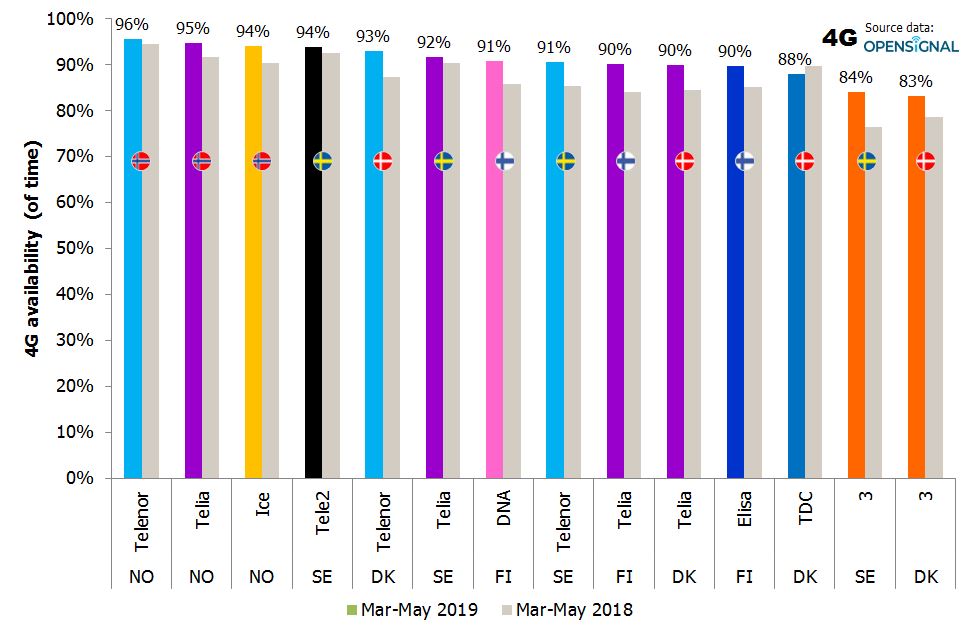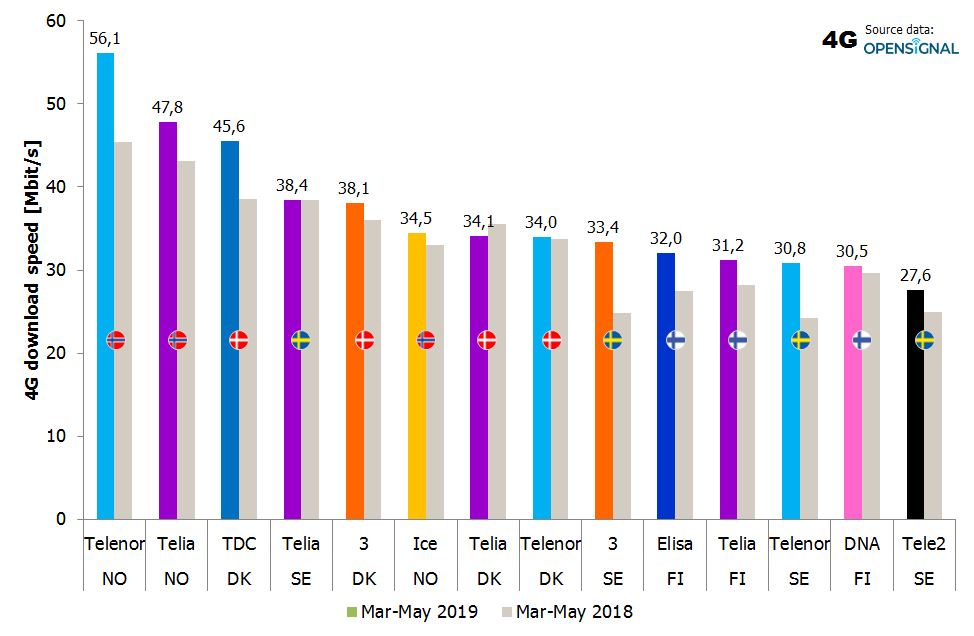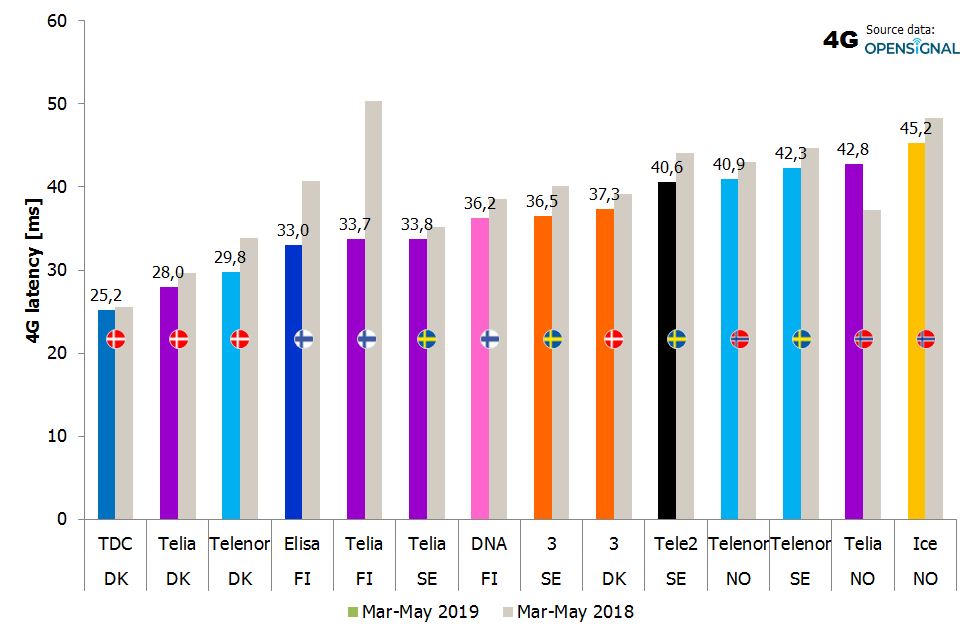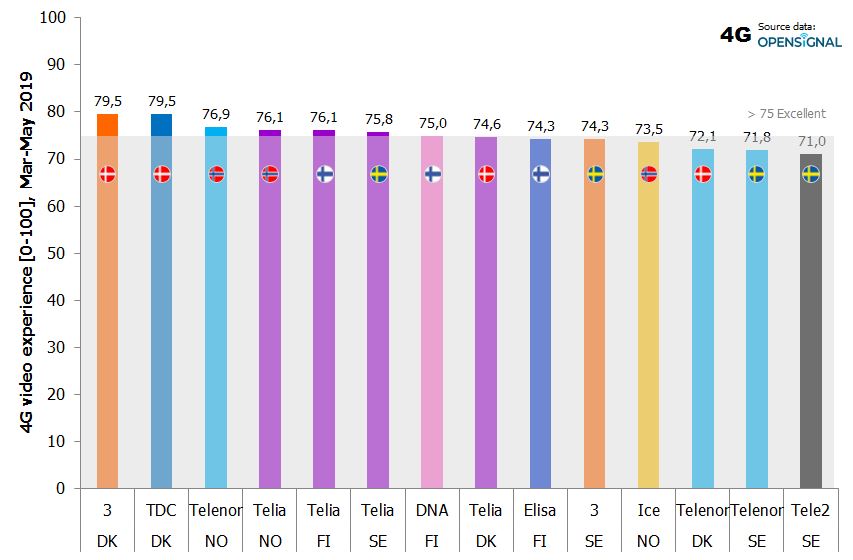This is our fourth comparison of the mobile network experiences in the Nordics based on performance data from Opensignal. There are more details and background is the previous (one–two–three) blogs.
This time the data is gathered from March to May 2019. The data has not been published by OpenSignal but has been shared with us through Opensignal’s analyst program.
4G availability
The graph below ranks the fourteen operators in Norway, Sweden, Denmark and Finland after how large proportion of time 4G capable devices have been connected to 4G. Opensignal calls this 4G availability.

Norway‘s three networks – Telenor, Telia and Ice – are ranked number one to three in the Nordics when it comes to 4G availability. Ice is still having a smaller network than its Norwegian competitors, but relies on national roaming on Telia’s network.
Tele2 is the best-ranked Swedish network – ahead of Telenor Sweden which it fully shares network (Net4Mobility) with. That can be explained by a different geographical distribution of subscribers – Tele2’s subscribers are slightly more often in the 4G coverage area of the shared network. Tele2 is good on 4G coverage, but within the coverage area the experience isn’t top notch – read on. 3 Sweden isn’t last in the Nordics when it comes to 4G availability any longer. 3 has taken a quantum leap in 4G availability in the past year.
In Denmark, Telenor is now the operator with the highest 4G availability. The improvement to the same period of 2018 is significant. Telenor shares network fully with Telia (TT-Netværket) and even though Telia’s 4G availability is lower than Telenor’s, also Telia has had an improvement compared to last year. Interestingly, the Danish market leader TDC is the only of the fourteen operators where the 4G availability decreased from 2018. 3 Denmark is now last when it comes to 4G availability in the Nordics.
The three Finnish operators DNA, Telia and Elisa have also improved 4G availability much in the past year. The difference between the operators is not very significant, but it must hurt a bit for Elisa to be ranked last of the three since Elisa traditionally used network superiority in its marketing. One reason to this could be that DNA and Telia are sharing network in the rural north and east parts of Finland (Suomen Yhteisverkko).
As a general comment – maybe with the exception of 3 Sweden and 3 Denmark – the 4G coverage builds of the Nordic operators are fantastic, particularly if considering the low population density of Finland, Norway and Sweden. To make a comparison within Opensignal’s data set, a subscriber to O2 in Germany (one of Europe’s largest operators) had a 4G availability of just 67% in the first quarter of 2019. That’s 28% percentage points lower than Telenor Norway.
4G download speed
We admit that we have become slightly blasé with regards to the fixation at download speed within our industry. With the help of Opensignal we will thus soon compare a new metric, but let’s anyhow first look at the 4G download speed and how it has developed compared to last year.

And the winner is again the company that seems to rate download speed as the most important business metric – Telenor Norway. Not only is the 56.1 Mbit/s speed impressive – it represents a major increase compared to 2018. Also Telia Norway and TDC Denmark deliver impressive speeds that improved much vs. last year.
Among our fourteen operators there’s just one, Telia Denmark, where the average speed decreased compared to last year. Its network sharing ally, Telenor Denmark, shows just a marginal increase suggesting that the shared network might suffer more under load than most other Nordic networks.
The speed experience of the Finnish networks isn’t the best in the Nordics. This is affected by a portion of Finnish subscribers being on lower-ARPU speed tiers, e.g. max 30 Mbit/s. The Finnish operators have however upped these tiers significantly in the past year (100 Mbit/s is the new standard) so the effect should be less today than what it historically was. A more likely explanation is therefore load.
A Finnish mobile non-M2M subscriber used roughly three times more mobile data per month in 2018 than what a subscriber in the other Nordic countries used:
- Finland 17.4 GB
- Denmark 7.1 GB
- Sweden 6.2 GB
- Norway 4.1 GB
(Low) load becomes a factor when considering the high download speeds of the Norwegian operators – and then particularly Telenor Norway that has the lowest mobile data usage of all fourteen operators. How fast would Telenor’s network be if it had the Finnish load?
More on this: Are fast networks fast because they aren’t used?
4G latency
5G networks are built with a promise of lower latency, but it will take some time before the 5G stand-alone standard that actually delivers lower latency is finalised and implemented. In the meantime, we conclude that there’s really not much wrong with 4G latency – at least not in Denmark.

TDC continues to lead in latency, followed by Telia and Telenor Denmark. The Finnish operators are doing quite well on latency as well – and the improvements of Telia and Elisa are impressive.
As with the other graphs, there’s one operator that doesn’t improve. This time it is Telia Norway where the 2019 latency actually is higher than the 2018 latency. If the Norwegian operators do well on 4G availability and 4G download speed, they are not doing that well on latency.
4G video experience score
Now to Opensignal’s new metric: Video experience score. As a significant, and growing, share of the mobile data traffic actually is video, it makes perfect sense to strive to measure the experience of consuming video. This is how Opensignal defines it:
“To calculate Video Experience, we directly measure video streams from end-user devices, using an ITU-based approach to quantify factors such as load times, stalling and video resolution over both an operator’s 3G and 4G networks. Video Experience for each operator is calculated on a scale from 0 to 100.”
Since all of our other metrics in this blog are 4G-only, we are comparing the 4G video experience score here. It is the video experience a mobile subscriber could expect when within 4G coverage (so consider the first chart on 4G availability).

Opensignal defines a video experience score above 75 as ‘excellent’. In the chart we have dimmed the part of the graph lower than 75.
Half of the Nordic operators are delivering a 4G video experience rated as ‘excellent’. 3 Denmark delivers the best experience – 79.5. When interpreting this, it’s important to remember than 3 Denmark is the operator with the worst 4G availability. When outside of 4G and on 3G the video experience is just 59.6. That’s on par with the other Danish operators, but we should remember that the average subscriber of 3 Denmark is on 3G a high 17% of the time. Given that, we suggest that the video experience of TDC Denmark is actually better albeit with marginally lower score.
Tele2 and Telenor Sweden are lowest ranked in 4G video experience. While their scores (71.0 and 71.8) aren’t catastrophic at all – Opensignal rates them ‘very good’ – it’s clear that the low download speed and the high latency of Tele2 and Telenor (who share network) has a negative impact on the factors that make up Opensignal’s video experience score; load time, stalling and video resolution.
